Case Study: Database Application
Learning Outcomes:
1: Explain the characteristics of relational databases and their role in creation and communication of business intelligence.
2: Identify and assess IT controls, auditing, ethical, privacy and security issues with respect to information.
3: Apply technical knowledge and skills in creating information for the workplace using spreadsheets and relational databases.
4: Communicate with IT professionals, stakeholders and user groups of information systems.
Context:
The aim of this assessment is to assess the student's ability to solve business problems using database design tool and software. It also aims to enable students to think about the impacts of using IT in Businesses and communicate key issues through a written report. Many businesses depend on the accurate recording, updating and tracking of their data on a minute-to-minute basis. Employees access this data using databases. An understanding of this technology allows business professionals to be able to perform their work effectively.
Instructions:
You need to design and implement the database using LibreOffice Base.
(1) Provide a word document containing the following:
a. Introduction - a summary of the case study
b. Justification of the use of database
c. Database Design: E-R Diagram
d. Ethical, privacy and security issues
(2) Provide the LibreOffice Base files used in creating the tables, forms, queries and reports
Case - Susan's Custom Apparel
Required:
Q1: Why does Susan needs a database for her business? Provide justification for your answer.
Q2: Create an E-R Diagram using Diagram Editor for Susan's business.
Q3: Create tables in a database using the following guidelines. Use LibreOffice Base for creating this database.
(a) Enter at least seven records for the products: two types of t-shirts (short and long sleeved), two types of fleece jackets (pullover and zipped), hoodies, baseball caps, and fleece hats. Assume that all apparel except headwear comes in small, medium, and large sizes.
(b) Enter records for at least nine customers. Use your own name, address, telephone number, and e-mail address to create an additional customer record. Assume that the business comes from your university town and one other town nearby.
(c) Each customer should have at least one order; a few customers should place two orders. Each order should contain multiple items.
(d) Appropriately limit the size of the text fields; for example, a telephone number does not need the default length of 255 characters.
Q4: Create a form and subform based on your Orders table and Order Line Item table. Save the form as Orders. Your form should resemble that in Figure 1.
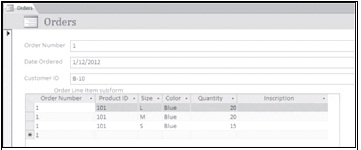
Q5: Create the following queries in your database
(a) Query 1: Create a select query called Products Less Than $20 that displays a list of all products that cost less than $20. Your output should resemble that shown in Figure 2, although your data will be different.
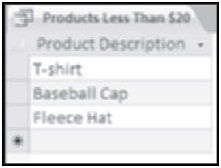
(b) Query 2: Create a parameter/update query that prompts for the incremental amount of a price increase and then prompts for the product description. Save the query as Updated Prices. Test the query by adding $0.25 to the cost of a product. View the changed price in your datasheet view of the updated table.
(c) Query 3: Create a query called Favorite Colors. List the colors of the products ordered and determine how many have been ordered of each; report the amounts in a column 5abelled Number Ordered. Sort the query output. Note the column heading change from the default setting provided by the query generator. Your output should resemble the format shown in Figure 3, but the data will be different.
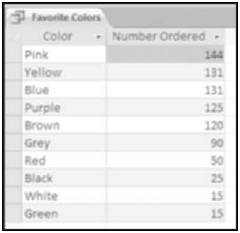
(d) Query 4: Create a query called Best Selling Product. List the product descriptions and determine how many orders have been received for each product. Report the amounts in a column 6abelled Number Ordered. Sort the output. Note the column heading change from the default setting provided by the query generator. Your output should resemble the format shown in Figure 4, but the data will be different
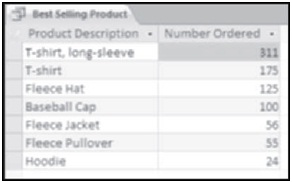
(e) Query 5: Create a query called Best Customers that lists the customers' names, phone numbers, and the total amounts of their orders. You will have to calculate the order amounts and sort the output. Note the column heading change from the default setting provided by the query generator. Your output should resemble the format shown in Figure 5, but the data will be different.
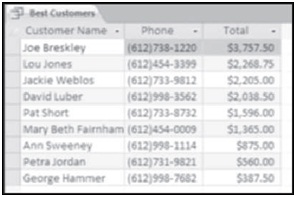
Q6: Create the following reports in your database
(a) Report 1: Create a report named Customers' Orders. The date range for the report should be displayed at the top. The report's output should show headings for Customer Name,Product Description, Quantity, New Price, and Total. All of this data originates in a query, in which all customers who live in a specified city receive a 10 percent discount. All other customers pay the full price. The discounted price or full price is noted in the New Price column. Then you calculate the amount of money owed for each product, which is the New Price multiplied by the Quantity. Save the query as For Report, bring the query data into a report, and group the report on Customer Name. Make sure that all column headings and data are visible and that all money amounts are formatted properly into currency. Depending on your data, your output should resemble that shown in Figure 6.
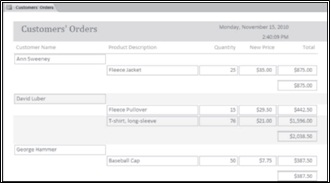
(b) Report 2: Bring the Favorite Colors query output into a report. Save the report as Favorite Colors. Make sure that all column headings and data are visible. Depending on your data, your report should resemble that in Figure 7.
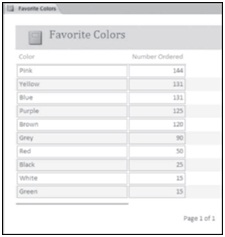
Q7: What ethical, privacy and security issues Susan might encounter when using database?
Accounting Information Systems Assignment Help service is the leading in the industry and has gained the trust of numerous students from all over the world!!
Tags: Accounting Information Systems Assignment Help, Accounting Information Systems Homework Help, Accounting Information Systems Coursework, Accounting Information Systems Solved Assignments, Database Application Assignment Help, Database Application Homework Help, E-R Diagram Assignment Help, E-R Diagram Homework Help